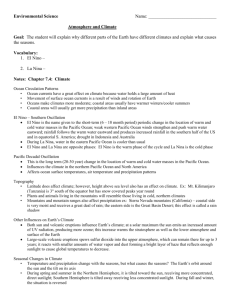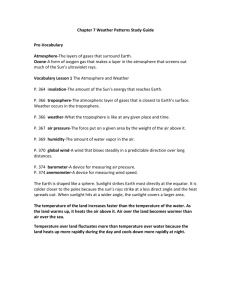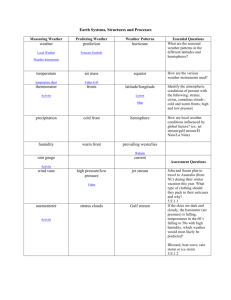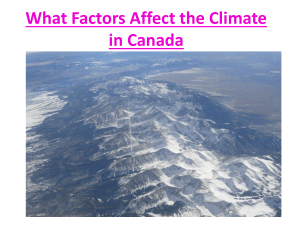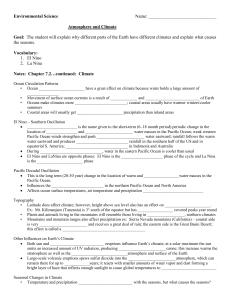Weather study guide
advertisement
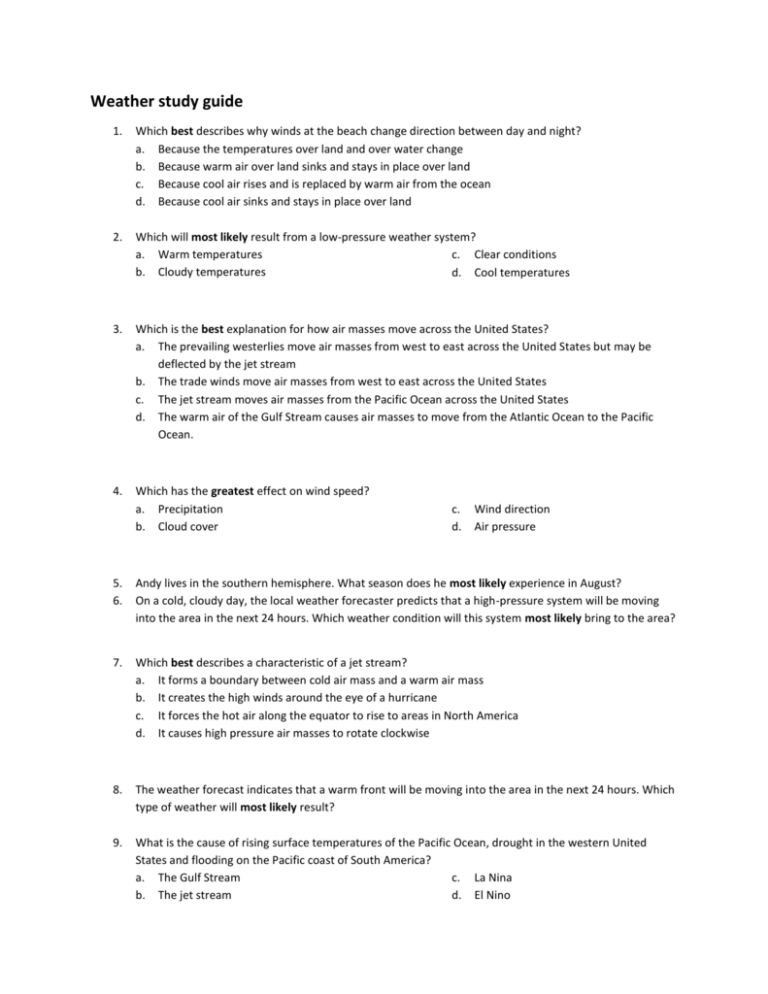
Weather study guide 1. Which best describes why winds at the beach change direction between day and night? a. Because the temperatures over land and over water change b. Because warm air over land sinks and stays in place over land c. Because cool air rises and is replaced by warm air from the ocean d. Because cool air sinks and stays in place over land 2. Which will most likely result from a low-pressure weather system? a. Warm temperatures c. Clear conditions b. Cloudy temperatures d. Cool temperatures 3. Which is the best explanation for how air masses move across the United States? a. The prevailing westerlies move air masses from west to east across the United States but may be deflected by the jet stream b. The trade winds move air masses from west to east across the United States c. The jet stream moves air masses from the Pacific Ocean across the United States d. The warm air of the Gulf Stream causes air masses to move from the Atlantic Ocean to the Pacific Ocean. 4. Which has the greatest effect on wind speed? a. Precipitation b. Cloud cover c. d. Wind direction Air pressure 5. 6. Andy lives in the southern hemisphere. What season does he most likely experience in August? On a cold, cloudy day, the local weather forecaster predicts that a high-pressure system will be moving into the area in the next 24 hours. Which weather condition will this system most likely bring to the area? 7. Which best describes a characteristic of a jet stream? a. It forms a boundary between cold air mass and a warm air mass b. It creates the high winds around the eye of a hurricane c. It forces the hot air along the equator to rise to areas in North America d. It causes high pressure air masses to rotate clockwise 8. The weather forecast indicates that a warm front will be moving into the area in the next 24 hours. Which type of weather will most likely result? 9. What is the cause of rising surface temperatures of the Pacific Ocean, drought in the western United States and flooding on the Pacific coast of South America? a. The Gulf Stream c. La Nina b. The jet stream d. El Nino 10. What will most likely result when the jet stream moves across North Carolina? a. North Carolina will experience tropical weather conditions. b. North Carolina will experience hot, dry weather c. North Carolina will experience mild weather. d. North Carolina will experience cold weather. 11. What is weather? 12. Which of these is a current in the atmosphere? a. Gulf Stream b.El Nino c. jet stream d. La Nina 13. Which condition suggests that a change from fair to stormy weather is most likely on the way? a. Constant air pressure c. Decreasing wind speed b. Decreasing air pressure d. Increasing air pressure 14. Which of the following is a warm ocean current that helps keep weather along North Carolina’s coast mild during the cooler months? a. Gulf Stream c. Jet stream b. El Nino d. La Nina 15. Which front will most likely bring clouds and precipitation for several days? 16. Which word best describes the weather during spring in North Carolina? a. Mild c. Dry b. Hot d. Cold 17. A weather forecaster says that a cold air mass will bump against a warm air mass. Which type of weather will most likely happen? a. Rainy and warmer c. Fair and warmer b. Colder with thunderstorms d. Fair and colder 18. Which of these forms over a warm ocean water and can bring strong winds and heavy rain to North Carolina’s coast in summer or fall? a. Hurricane c. Thunderstorm b. Snowstorm d. Hail 19. Describe cirrus clouds? 20. Which correctly describes El Nino? a. An unusual cooling of water in the eastern Pacific Ocean b. A cold current in the atmosphere that flows across the United States c. An unusual warming of water in the eastern Pacific Ocean d. A warm ocean current that flows across the Atlantic Ocean 21. Earth’s weather occurs almost completely within the atmosphere layer called the ___________. 22. The boundary between two unlike air masses is a __________________. a. Prevailing wind c. Front b. Station model d. Knot 23. On a weather map, a line with a row of triangles on one side shows the location of a __________________________ 24. Weather fronts move generally from ___________________________. a. West to east c. North to south b. East to west d. South to north 25. A front moving toward an area typically means ____________________. a. The greenhouse effect c. No change in weather b. Changing weather d. A tornado is forming 26. Two factors can cause clouds to form when water vapor cools. They are_____________. a. Precipitation and convection b. Evaporation and low air pressure c. Condensation and dust particles d. Humidity and high air pressure 27. Both hurricanes and tornados have centers with very low ______________. 28. In sunny dry weather, the air pressure is _______________ and the relative humidity is _______________. a. Low, high c. High, high b. High, low d. Low, low 29. To measure wind speed accurately you would use _____________. 30. Some scientists have observed that the Earth’s average temperatures are increasing. This change is known as________________. 31. The amount of water vapor in the air compared with the greatest amount that could be in the air at that temperature and pressure is ___________. 32. Examples of precipitation include 33. Describe two weather conditions and identify instruments used to measure them. 34. Compare stratus and cumulus clouds. What do they look like? In what kind of weather are you likely to see them?
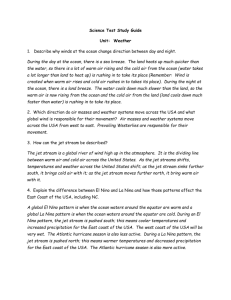
![Weather_Review_HW[1]](http://s3.studylib.net/store/data/006649734_1-838a8b8e383ea61d359b3efce7382f09-300x300.png)
